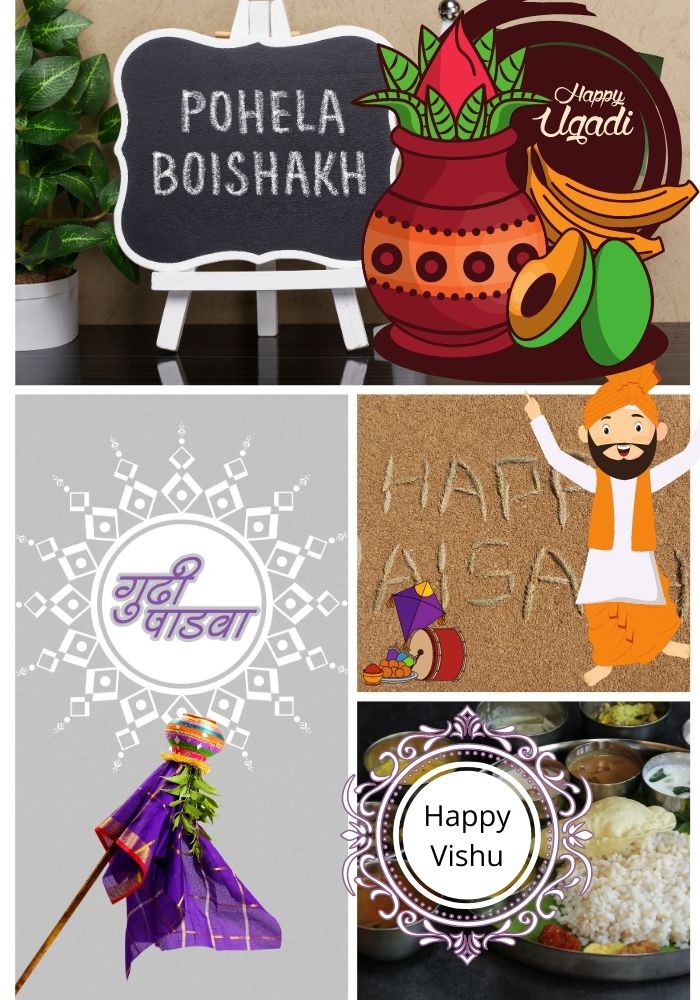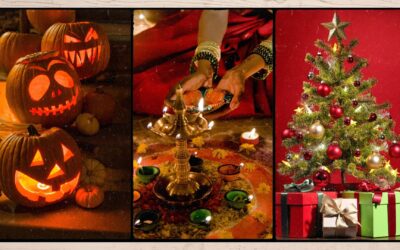If you ask someone, “What are you doing for New Year’s?” in the middle of April – you will probably get, “Do you mean what I already did for New Year’s?” because the only date that pops in mind for New Year’s is January 1st – the new year day based on the most widely used calendar around the world, which is Gregorian. And yet, the beginning of the new year varies so widely all around the world and is celebrated at all times of the year (February to September)!
How we track time and celebrate time can tell us a lot about how we relate to the world around us. India celebrates the beginning of the year in 12 different ways based on the different regions and different faiths.
Ten of the regions celebrating in April this year:
April 13: Andhra, Karnataka, Maharashtra, Punjab and Kashmir celebrate Ugadi, Gudi Padwa, Vaisakhi and Navreh.
April 14: Tamil Nadu, Kerala, Orissa and Assam ring in Puthandu, Vishu, Pana Sankranti and Bohag Bihu.
April 15: Bengal celebrates Pohela Boisakh.
A common theme in all these celebrations is the start of the new year and the arrival of Spring. Ugadi the festival of Andhra Pradesh and Karnataka, means the beginning of a new age (Yug- era) and (Adi-new beginning). Gudi Padwa celebrates this day as the day this whole universe was created. Pohela Boisakh also means the first day of the month of Spring. The onset of harvest is marked by Bihu and Baisakhi and so on.
Many of these celebrations are based on the lunisolar calendar – meaning it follows the cycles of a combination of the Moon cycles and Sun cycles.
A Solar year lasts 365 days, while a lunar year, or 12 full cycles of the Moon, lasts 354 days. Because of this discrepancy, a purely lunar calendar like the Islamic, or Hijri calendar — may have holidays falling in different seasons. For example, the holy month of Ramadan may fall in Spring this year, and winter a number of years later.
The combination (lunisolar) calendars followed by Hindu, Chinese, Jewish and many others – make up for the difference in days by adding an extra month so that the dates are roughly matched up with the Solar dates.
Significance of The Lunisolar Calendar
It’s interesting to note that although the Gregorian calendar marks the beginning for all practical and financial planning across the world, the lunisolar calendar still plays an important role for ethnic festivals and celebrations and many everyday lifestyle choices in many regions.
As much as I love the light-hearted, free flowing, fun celebration of the New year’s day on Jan 1st, I definitely also like the focus on family, specific food, specific kind of decorations, and prayers, as a way of celebrating the ethnic New Year.
The lunar/lunisolar calendars around the world, are a reminder to reconnect with everyone and everything around us. They help guide farming activities and seasonal food habits like eating neem, mango and jaggery during spring to be stronger in warding off allergies and colds! or help stay aligned with the stars in picking auspicious dates and times for major life events! Or even just be able to tell which day of the month it is, by gazing up at the moon in the sky!
The solar based calendar brings perspective on a linear progression of things, and the lunar or the lunisolar calendars help us focus on the ebb and flow of events in life that are more cyclical, like the phases of the moon.
By letting ourselves accept the Gregorian calendar as the only ‘natural’ one, have we skewed the balance similarly by focusing only on the solar energy and forgetting about the role of the lunar energy in our lives? While we need goal setting, planning, organization and discipline that a Gregorian calendar brings in our life, don’t we also need to stay aligned with the seasons, our eating habits and lifestyle, moods, and the cosmos in general?
So, while we celebrate these Spring/New Year festivals this year with food, decorations and other festivities (you can read more about the festivities themselves here), why not learn a little about the lunisolar calendar that plays such an important role and yet we know so little of?
Learning to Read the Lunisolar Calendar
With that in mind, this year, for Ugadi and Pohela Boisakh, which is what I celebrate at my home, I took some time to learn a few things about the lunisolar calendar and was pleasantly surprised! Although the calculations are very intricate and complex, not to mention impressive, I became familiar with the names of the months and days – something I’d heard my parents, grandparents use in so many different contexts (but had remained thus far in a blurred background).
Here are two things I learnt to do and you may have fun trying too:
1. Decode the Date Structure
For example, the date of Ugadi would be “Chaitra Masam, Shukla Prathipada” – which means the first day of the waxing moon in the month of Chaitra.
You’ll need the names of the months and names of the days to decode that. So here goes:
The twelve months of the calendar as they correspond to the Gregorian calendar:
Now the days:
Indian months are also divided into two halves of 15 days each, the first 15 for the waning moon and the second 15 for the waxing moon. The days are called Pratipada, Dwitiya, Tritiya, Chaturti, Panchami, Shashti, Saptami, Ashtami, Navami, Dashami, Ekadashi, Dwadashi, Trayodashi, Chaturdashi and Amavasya respectively.
2. Find your Lunisolar Birthdate
Well, this one isn’t technically learning to do it because I just found an app that does it! As it turns out, it’s a lot more complicated to calculate and definitely not something that you can figure out by knowing the names of the months and days alone. So, have fun using this website to figure out your birthday!
Next, I might try and plot the Jan 1st New year or Christmas on the lunisolar calendar! Will be interesting to see how that date would change when seen from the perspective of the lunisolar calendar!
If you are also celebrating Ramdan this month, would love to hear about the months and days in the Hijri Calendar! Let us know in the comments below.













0 Comments